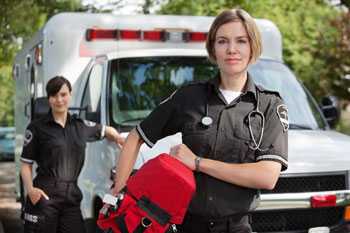Public Safety Program
Emergency Medical Service

Emergency Medical Services (EMS) workers provide pre-hospital emergency medical care. Their duties create an inherent risk for on-the-job injuries and illnesses. Research shows that EMS workers have high rates of fatal injuries and nonfatal injuries and illnesses. Visit this NIOSH Topic Page for a list of current projects, data, and additional publications and resources.
NIOSH Resources and Publications
Motor Vehicle Safety
Provides background and resources related to work-related motor vehicle safety. Includes a listing of publications specific to Vehicle Safety for Firefighters and Emergency Responders.
NIOSH Program Portfolio: Emergency Preparedness and Response
The mission of the NIOSH Emergency Preparedness and Response (EPR) Program Portfolio is to advance research and collaborations to protect the health and safety of emergency response providers and recovery workers by preventing diseases, injuries, and fatalities in anticipation of and during responses to natural and man-made disasters and novel emergent events.
Seasonal Influenza (flu) in the Workplace
NIOSH works with colleagues and other partners to conduct research and make recommendations to minimize work-related risks of catching influenza. Throughout the influenza season, this topic page is updated and expanded to include a variety of resources for employers, workers, occupational health professionals, and other partners.
Healthcare Workers Safety and Health
Highlights of the occupational injury risks of healthcare workers. Provides links to documents and resources related to injuries and illnesses among healthcare workers.
Preventing Exposures to Bloodborne Pathogens among Paramedics
A national survey of 2,664 paramedics contributed new information about their risk of exposure to blood and identified opportunities to control exposures and prevent infections.
Interim NIOSH Training for Emergency Responders: Reducing Risks Associated with Long Work Hours
NIOSH training designed for emergency responders who often work longer shifts. This training focuses on the importance of being well-rested and tips to reduce the risks of fatigue during operations.
NIOSH Continues Research to Improve Safety for Ambulance Service Workers and EMS Responders
Researchers at NIOSH set out to reduce ambulance crash–related injuries and deaths among EMS workers. Research addressed the layout and structural integrity of ambulance compartments, design of hardware, and occupant restraints.
Fentanyl: Preventing Occupational Exposure to Emergency Responders
Fentanyl is a powerful synthetic drug similar, yet much more potent, to morphine and heroin. Emergency first responders have a high risk of coming in contact with the drug, unknowingly from its many forms. Exposure can be quick and lethal.
Non-NIOSH Publications
Organizations
National Highway Traffic Safety Administration, Office of Emergency Medical Services
NHTSA, Office of Emergency Medical Services – EMS Research
American College of Emergency Physicians (ACEP) – EMS and Disaster Preparedness
Emergency Responder Safety Institute
National Association of Emergency Medical Technicians
National Association of State EMS Officials
Department of Homeland Security: First Responders Group
Ambulance Manufacturer’s Division of the National Truck Equipment Association (AMD–NTEA)
- Page last reviewed: January 4, 2017
- Page last updated: August 30, 2017
- Content source:
- National Institute for Occupational Safety and Health Office of the Director


 ShareCompartir
ShareCompartir